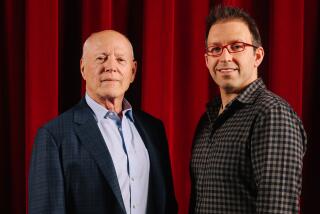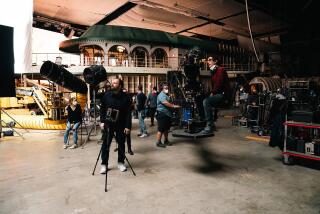Siegfried & Roy’s Latest Is No Illusion
When Siegfried Fischbacher of “Siegfried & Roy” fame was first approached about doing a 3-D Imax film about the pair’s spectacularly successful Las Vegas act, he was less than thrilled.
“I need this movie like I need a hole in the head,” he told filmmaker Brett Leonard.
Leonard understood their reluctance. “I knew they wanted to make a larger film then just one to show off their success. And I realized that theirs is an archetypal story. I saw their story as a spiritual journey. So I realized that whatever my response to Siegfried was, it better be good.”
Whatever Leonard said, it worked. The Imax film based on their show, “Siegfried & Roy: The Magic Box,” opened Friday at the California Science Center in Los Angeles and at Edwards’ Imax Theaters in Irvine, Ontario and Valencia.
Roy Uwe Ludwig Horn, who in a recent interview made himself the center of attention and pronounced his heavily German-accented English through possibly the whitest teeth on the planet, joked: “Imax promised us it is going to be the biggest movie of the year. We thought they were kidding. And then we realized the movie is eight or 10 stories high. So, of course, it is going to be the biggest movie.”
Indeed, Imax has high hopes for the film’s success, on the order of last year’s “Everest,” which has grossed more than $72 million.
“Magic Box” is more than a concert film of the duo’s long-running act at the Mirage, where the illusionists have had a record-setting 25-year sold-out run. The movie concentrates instead on the remarkable professional and personal relationship of the German-born pair--they’ve been domestic partners for more than 30 years--and their work to save the royal white tigers and white lions of Timbavati. The men breed these magnificent-looking animals at Jungle Paradise, a 100-acre preserve on the edge of Las Vegas, and have incorporated them into the grandest illusions in their live show.
Film Straddles Science and Magic
Unusual for an Imax film, “Magic Box” will play in both educational (California Science Center) and commercial (Edwards cinemas) locations. “‘We’ve totally bridged the gap. And in all honesty that surprises me because there is no science in this film,” said Leonard, whose company, L-Squared, produced the film. “It just works on a human level.”
California Science Center marketing executive Joe DeAmicis said the film will be shown there because “there is science in magic.” And unlike “T-Rex” (Leonard’s last film), which has scientific inaccuracies, no one is going to mistake “Siegfried & Roy” as an educational film.
Siegfried, 60, and Roy, 55, came to Los Angeles recently to promote the film and receive a star on the Hollywood Walk of Fame. As usual, they’re surrounded by an entourage: a nattily dressed manager, a worried-looking publicist, crews to adjust lighting and attend to a white tiger cub. Others stand by ready with makeup, water and cell phones. Siegfried and Roy do not travel lightly.
Dressed in an expensive-looking, emerald-colored suit and chain-smoking cigarillos, Siegfried was more subdued, occasionally muting Roy’s exuberance with a firm hand to his friend’s shoulder. “The illusion and magic in our live show is the driving force,” he explained. “But in the movie it is our life story.”
“It’s scary. I think we give away the secret of how we grew up,” Roy said. “We came from literally nothing in postwar Germany.” Both men came from dysfunctional families, their fathers’ spirits broken by the war.
Playing Up the Horatio Alger Angle
Siegfried and Roy and Co. talk in the rhetoric of showmen; they aren’t afraid of hyperbole. “It’s the whole Horatio Alger story,” said their manager, Bernie Yuman. “Where do you find two people that get off of a boat at Pier 44 in New York City, walk up to Radio City Music Hall and watch the Easter show, and never dare to dream that on the same stage 25 years to the date, they would break the 57-year record for attendance and gross?” (Dramatic pause.) “Siegfried and Roy?”
Unfolding like a storybook, Leonard’s film is seen through the eyes of the young Siegfried and Roy. We watch the teenage Roy, played by Andrew Dunlap, spend time at the Bremen Zoo where he befriended and eventually liberated Chico the cheetah. The film also re-created Siegfried and Roy’s first meeting in 1960 on a New York-bound cruise ship, where Siegfried was resident magician and Roy and Chico joined his act.
“When you see the Bremen Zoo [in the film], it is just how I remember it,” Roy said. “Everything was a jail. I was close to the animals because I felt jailed up in my little hometown just the same.”
Siegfried too had to dig back into painful memories. “It was very revealing to discuss the relationship with my father,” he recalled. “For me, the magic book [Siegfried discovers in a merchant’s window] was not so much about learning some card tricks. I thought that if I could have this magic book, then I could solve the problems at home.
“When I learned my first trick and showed it to my father, that was the first time in my life he noticed me. So I think magic became a life, and I grew to realize that life is magic.”
The more Siegfried and Roy revealed about their lives, the more Leonard discovered a symbiosis between these memories and specific elements in Siegfried and Roy’s live show, much of which is seen in the film. And with the help of a top-notch special effects team--headed by director of photography Sean McLeod Phillips, who also oversaw the effects on “T-Rex”--Leonard found dynamic ways to intercut them. The film is further heightened by Anthony Hopkins’ narration and an original score by film composer Alan Silvestri (“Forest Gump” and “Back to the Future”).
“If I had gone for a straight documentary style and then jumped back to their childhoods, it would have been disjunctive,” Leonard said. “I wanted to create an environment of storytelling utilizing 3-D Imax that will appeal to children of all ages.”
Along with the storybook images came the very real danger of filming while lions and tigers roamed free at the Jungle Palace, the Mirage and Little Bavaria, as Siegfried and Roy’s private home is called. His sleeve pulled up to reveal a fresh cut along his wrist, Siegfried said, “We did not know how the animals were going to react. [The filmmaking process] is very threatening to them.”
Finishing his sentence, Roy added, “Suddenly 150 Hollywood people move in and everything changes. They invade you. You have no privacy.”
“That was the fun part,” Leonard said to Siegfried. “We shot a scene where you walk though your house with an 800-pound white lion, and nobody knows what’s going to happen. . . . The animals would walk toward the camera and stare at just the perfect minimum-focus distance. They gave us the most amazing shots just like they give in the show every night.”
Early on, Leonard remarked that the film signaled Siegfried and Roy’s desire to retire. If so, “Magic Box” is something they can leave as a legacy. Yuman won’t give a time frame for his clients’ withdrawal from show biz, but said, “At some point Siegfried and Roy will retire. And this film will be the only reference. The entire spectacle, all of the magical moments are in this movie.”
More to Read
Only good movies
Get the Indie Focus newsletter, Mark Olsen's weekly guide to the world of cinema.
You may occasionally receive promotional content from the Los Angeles Times.










